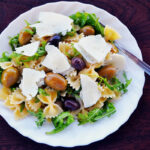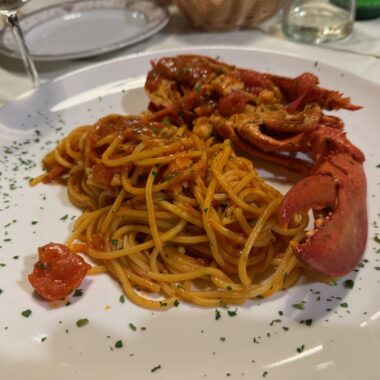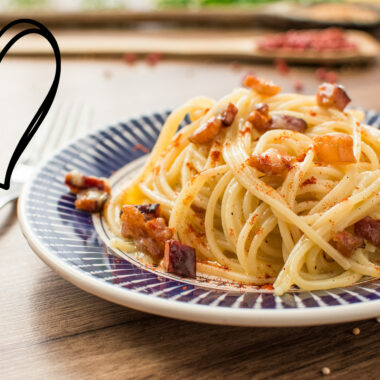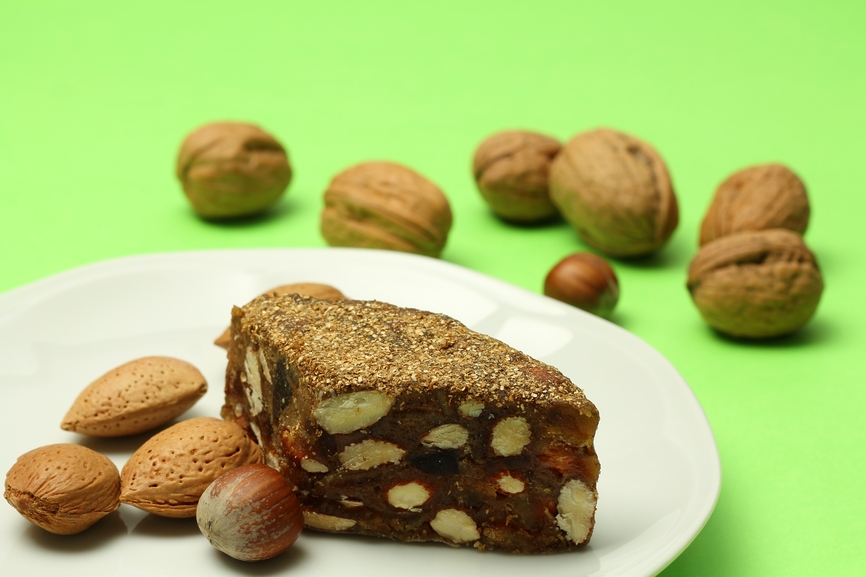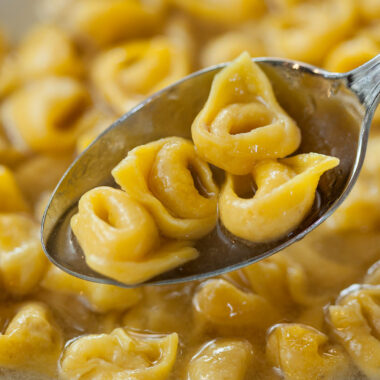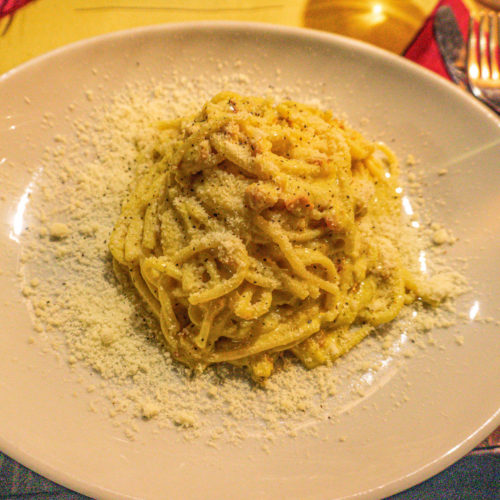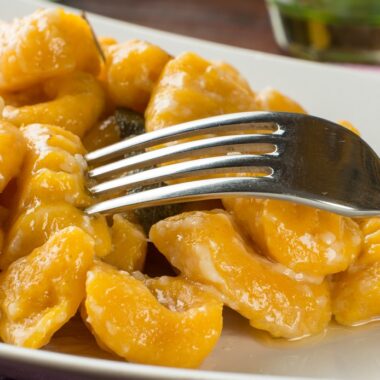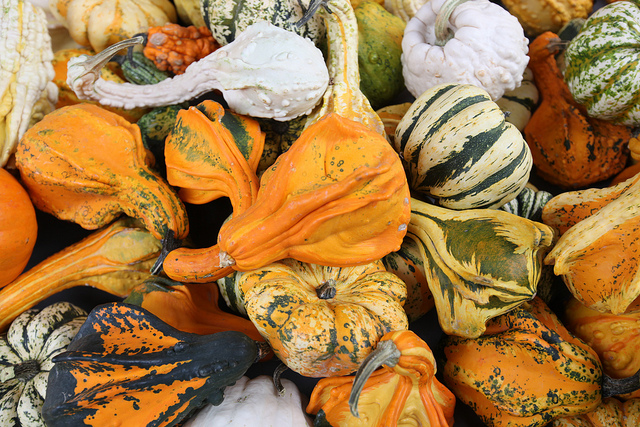You know we Italians are proud of our food. You know also we do have tricks, secrets and downright spells we use in the kitchen to make stuff that delicious (ok… ok… we’re not the only ones, of course!). Italian cuisine is among the best in the world, and it’s certainly also down to its variety and versatility. But if you have Italian friends or family, you may have noticed something peculiar: sometimes, the way your mate cooks something is different from the way your aunt does it. Both excellent cooks, both Italians, different recipes. Of course, each family has traditions and each person likes to add something personal to recipes sometimes, but it’s undeniable some dishes have more variations in their recipes than others. Why does this happen? Well, sometimes it’s down to the availability, especially in the past, of a certain ingredient in a given area, sometimes to personal tastes or food trends of old, which have remained so ingrained in tradition to have become tradition themselves. Some are just changes made because they taste good.
Whichever the reason, here you’ll find some interesting recipe variations for 5 of Italy’s best known –and loved– dishes: carbonara, pasta e fagioli, melanzane alla parmigiana, pollo alla cacciatora and tiramisù. And you, how do you cook your own?
Pasta alla Carbonara
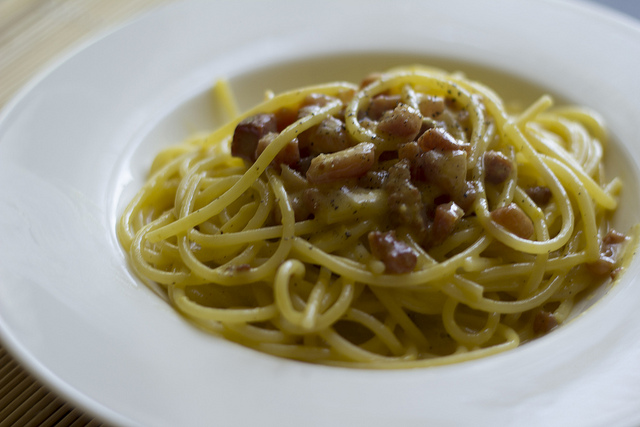 Variations in the kitchen: pasta alla carbonara (Luca Nebuloni/flickr)
Variations in the kitchen: pasta alla carbonara (Luca Nebuloni/flickr)
Variations or not, we’re talking Italian cuisine royalty here: who doesn’t know carbonara nowadays? Easy and cheap to make, carbonara has rightly become a staple dish on Italian tables and has gained fame and popularity abroad, although I refuse to call carbonara some eccentric variations I was served when living in Ireland: just to make things clear, mushrooms are not part of carbonara and yes, you do need the egg in it.
Beside the evident fails of celtic tiger-style-recipe evolutions of the dish, even we Italians seem to have some issues about the actual way to make it.
If we all agree on the essentiality of the egg and a sprinkling of black pepper on top, there are a couple of points upon which we can’t seem to agree: “cream or no cream,” “guanciale or pancetta,” “pecorino or parmigiano”, “garlic or no garlic”, “onion or no onion”‘,”entire egg or just the yolks”?
Whether you should pick guanciale or pancetta is a mystery often solved by geographical location: for instance, in my area (Piemonte and Liguria) guanciale (which can be compared to the US jowl bacon) is not as popular as it is in the centre and the south of the country, so we tend to use pancetta instead. Also, guanciale does have a slightly different taste from pancetta, fuller and stronger, which may not be appreciated by all, so many families pick pancetta over guanciale to keep everyone around the table happy. However, considering the dish has central Italian origins, it’s probable that the original recipe of carbonara called for guanciale and not for pancetta.
In any case, both should be thickly sliced or diced and never machine cut.
We enjoy to have a similar diatribe over the type of cheese to use for carbonara: parmigiano or pecorino romano? Truth is that, very likely once again, the original recipe called for pecorino, but many people today choose parmigiano, especially in the North. Plenty like to sprinkle on top of their flavorsome, piping hot spaghetti a handful of both.
Pancetta and guanciale, parmigiano and pecorino romano… sure, these may rise the heat in the kitchen a bit, but the one that breaks marriages and frienships is the “cream or no cream” question. If supporters of guanciale may tolerate those of pancetta, and lovers of parmesan are ok with those of pecorino, the issue of cream in carbonara is one that divides the country like soccer. The original recipe calls for the sole use of eggs, which should be beaten and mixed with the chosen cheese and then added to the pasta and guanciale/pancetta combo. Some people, however, like to substitute one egg (we usually say one egg per person) with 100 ml of cream to achieve a more delicate and creamier taste.
It sounds nice (and it is), but to many it’s the equivalent of a heresy. Sure, we’re not the Inquisition here at lifeinitaly, but I coily suggest to leave the cream out of your carbonara and enjoy the fuller bodied, more rustic flavor of the original version.
One last thing: while looking for photos to add to this very article, I kept encountering frightening pictures of spaghetti alla carbonara with a raw egg yolk in the middle, a clear sign the depths of misery reached with the celtic tiger carbonaras of yonder have been surpassed.
Pasta e Fagioli
 Variations in the kitchen: pasta e fagioli (Flavia Conidi/flickr)
Variations in the kitchen: pasta e fagioli (Flavia Conidi/flickr)
Pasta and beans is another traditionally Italian pasta dish, well loved all over the country. Delicious comfort food, its recipe has several variations, mostly due to the fact each region has a way to make it which differs slightly from the others. We’re talking geographical variations here, rather than culinary, as in the case of the addition of cream to carbonara: in Naples, for instance, pasta e fagioli is often cooked with cotiche (pork rinds) instead of lardo, or even with mussels. It’s also usual for Neapolitans to cook beans and pasta together, rather than separately as it happens in other parts of Italy, which makes the dish creamier and richer. Cotiche are also used in Rome, whereas the typical pasta e fagioli of the North (such as the one cooked in Veneto), uses lardo. The reason is easily explained by the fact cotiche are an ingredient more common in the centre and south of Italy, whereas lardo tends to be more of a northern Italian thing.
The main source of disagreement, however, the equivalent of the “cream or no cream” issue, is whether one should use tomato sauce or not. The choice doesn’t seem to be geographically dictated, but rather depends on each individual’s taste or family tradition.
Other variations of pasta e fagioli include the addition, beside the already mentioned mussels, of tuna, sausage and potatoes. Of course, not all at once…
Melanzane alla Parmigiana
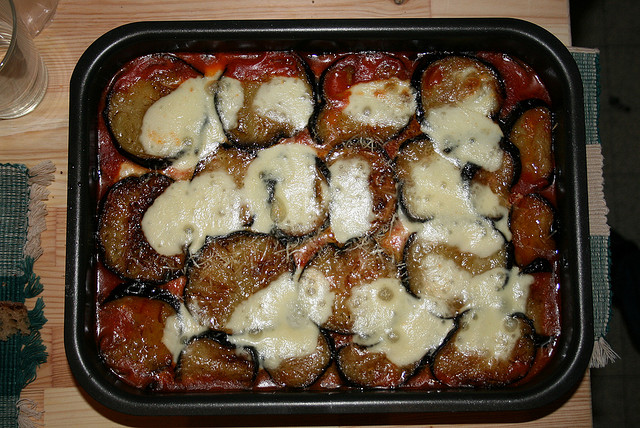 Variations in the kitchen: eggplant Parmigiana (ign11/flickr.com)
Variations in the kitchen: eggplant Parmigiana (ign11/flickr.com)
Melanzane alla parmigiana (eggplant parmigiana on your side of the pond) are one of my absolute favorite dishes. I was in Sicily last weekend and I witnessed a 20 minutes long conversation between my brother and a friend of his about how this man’s wife’s parmigiana was the best on earth. “Come fa la parmigiana la tua Concetta, non la fa nessuno!,”* my brother would say, receiving deep, serious nods in response from his friend. The point is: how does Concetta make it? Because eggplant parmigiana is a dish with a thousand faces and dozens of recipe variations.
A couple of considerations about the dish.
First of all, just as in the case of carbonara, the origins of melanzane alla parmigiana are dubious: both Sicily and Campania claim to be their place of origin, even though the dish is popular all over the country. For linguists, however, the adjective “parmigiana” has been associated, at least since the 15th century, to a specific way to slice, layer and bake vegetables typical of Parma.
In the 19th century, some cookbooks began to associate the same term with the use of parmigiano in dishes. Both linguistic suggestions could potentially be related to melanzane alla parmigiana, but there are others that could help pinpointing the origin of the dish to either Sicily or Campania. According, once again, to linguistic experts, the term “parmigiana,” at least in reference to the dish we are talking about here, has nothing to do with Parma. It could be the phonetic deformation of either a Neapolitan or Sicilian dialectal expression, the first (from the Neapolitan parmiciana) used to indicate the way wood slats are layered to create shutters, the second being the name of the typical variety of aubergines (the Sicilian petrociane) used to make the dish.
In any case, melanzane alla parmigiana are in the list of the Prodotti Agroalimentari Tradizionali Italiani (traditional food-farming products of Italy): a true symbol of the deliciousness of Italian cuisine.
But how many variations of this recipe are there around the country? Well, quite a lot.
Many say the original recipe calls for pecorino siciliano and not parmigiano; others debate whether mozzarella should be used (as the Neapolitans do) or not, others add scamorza. The very manner of prepping the melanzane is up for discussion: my stepmother, for instance, batters and fries them. Personally, I like to grill them, but many pan fry them. And, even if the most traditional recipe wants the sauce to be simple and made only with tomatoes, gourmets all over the country love to layer their parmigiana with meat sauces or add slices of ham to it. A recipe published in 1903 by Jeanna Carola Francesconi in her volume on traditional Neapolitan cuisine wants (beside the above mentioned mozzarella) also sliced boiled eggs in it.
The question about which among the many is the “right” recipe remains. Along with the secrets of Concetta’s Sicilian parmigiana.
Pollo alla Cacciatora
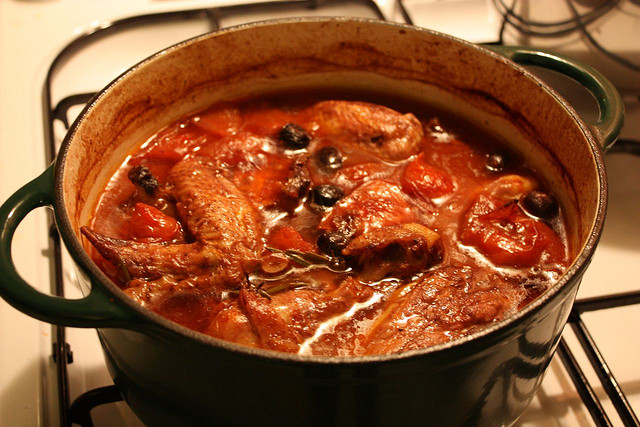 Variations in the kitchen: pollo alla Cacciatora (pocketcultures/flickr)
Variations in the kitchen: pollo alla Cacciatora (pocketcultures/flickr)
I love pollo alla cacciatora. My grandmother used to make it often, and it was her typical dish for the Giorno dell’Assunta, the 15th of August. As it happened with carbonara, my long permanence in the lands of Albion and Eíre taught me that, in some parts of Europe, Italian dishes’ names are applied a tad too loosely to concoctions that have little –if anything at all– to do with the real thing.
Let’s not linger on those horrors, but rather on the many variations of this popular Italian recipe within our own national borders.
Pollo alla cacciatora (litterally, hunter’s style chicken) is a type of chicken casserole most likely born on the hills of gracious Tuscany, so delicious the whole coutry made it her own. This is a quintessential piatto povero, made with ingredients each farmer would have, without need to spend extra money: the chicken (or, very often, the hen) would come from the chicken coop; the tomatoes, onions, carrots, celery and herbs from the orchard and the red wine either from the farm’s cellar, or that of a neighbor. Slow simmering on the stove and effortless to make, “si cuoceva da solo” (it would cook on its own), leaving the ladies of the house free to spend their time on other dishes, or in the fields. The ingredients I mentioned a couple of lines above are those my grandma would have used. Add fresh rosemary, olive oil, fresh laurel leaves, and a good full afternoon of slow cooking and you’d have her version of pollo alla cacciatora ready to savor.
And in fact, this is by many considered the basic recipe, upon which, however, variations have flourished and blossomed. If you happen to try pollo alla cacciatora in my region, Piemonte, where we love wild mushrooms and pick them aplenty during the Fall, you may notice their unmistakable scent rising from your plate, as many people do like to add some to their version of it. Mind, though: we’re talking about wild mushroom here, even dried ones if you like, not those white supermarket champignons!
Some people like their cacciatora with olives (I like it a lot!), which do give a pleasant kick to it. Others still, leave out the tomato, and simply cook the chicken in red wine and vegetables… Personally, I don’t know how I feel about this one: no doubt it is delicious, as anything made with fresh ingredients and cooked slowly is, but is it a pollo alla cacciatora? The jury is still out.
Tiramisù
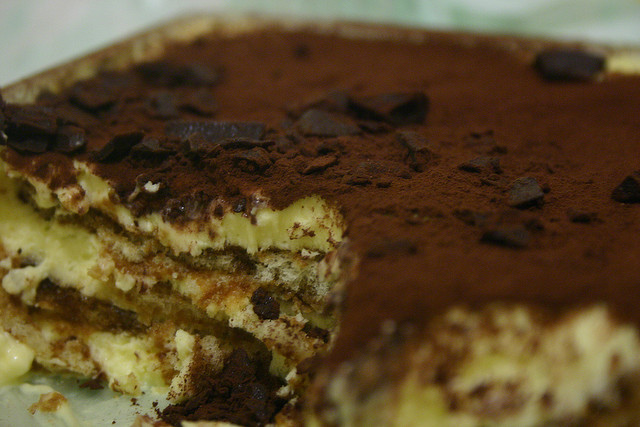 Variations in the kitchen: what about tiramisù? (Vincenzo Visciano/flickr)
Variations in the kitchen: what about tiramisù? (Vincenzo Visciano/flickr)
Of course, you couldn’t finish a nice, traditional Italian dinner without a nice, traditional Italian dessert: tiramisù. Our Katty gave you some hints on how to make a delicious tiramisù in your own kitchen, and we even talked a bit about its curious history when discussing Italy’s food legends. Tiramisù is famous and everyone in Italy loves it. And everyone in Italy makes it in a different way.
The most traditional recipe for tiramisù calls for a cream made with mascarpone, sugar and eggs, layered with savoiardi soaked in coffee and marsala, all topped with cocoa powder. It’s a simple combination, yet it nears perfection. It’s also one of the few dishes that doesn’t loose its identity when things are changed around a bit in it, or so I think (you may give us your opinion in the comments below!).
For instance, I always use savoiardi, but many swap them for other varieties of cookies, as Katty suggested in her recipe. After Christmas, when leftover panettone becomes a sort of kitchen curse in Italy, my step mother makes a delicious tiramisù using it instead of savoiardi.
Its rich, delicious mascarpone cream (that so often my college friends and I would polish off as a dip for savoiardi quicker than it’d take to make coffee) is made with ricotta by some, to lighten up the cake’s texture and calorie count.
If the presence of coffee remains an unchangeable staple of this recipe, the liquor is often omitted, especially if children are part of the dinner gang.
Tiramisù is like a Lego-dessert: you can change ingredients, mix and match flavors and still come out with a mouth watering cake: my step mother, once again, makes a fantastic summertime tiramisù, where she swaps coffee for fresh strawberries, layered upon the savoiardi, which are soaked in a sugar and lemon mix we use to dress fruits in the hot season. The cream is also lightened by leaving out the eggs and mixing together fresh vanilla, whipped cream and greek yogurt. It may not strictly be tiramisù, but I can guarantee you it’s amazing.
These popular dishes are far from being the only ones creating, sometimes, havoc in the kitchen and around the dinner table, but are certainly among the best loved in Italy… The only way to find out which is the best recipe variation is, alas, to make a *huge sacrifice* and try them all…
* “Nobody makes parmigiana like your wife!”

